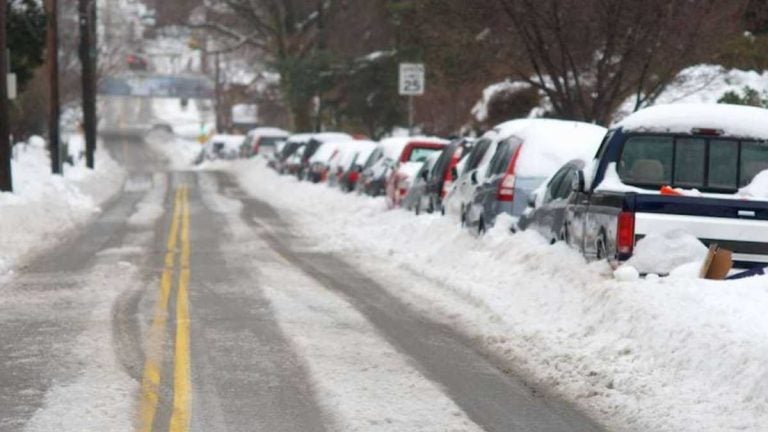With help from Drexel prof, snow-melting concrete may someday clear wintry roads

Slippery West Sedgwick Street in Northwest Philadelphia after a winter storm. (Bas Slabbers for NewsWorks, file)
Winter is coming, and that means snow and ice on the roads — and scattering salt and de-icing chemicals.
But a researcher at Drexel University has helped come up with a new approach to the annual problem — concrete that can de-ice itself.
When snow covers the roads or icy rain slickens them, we depend on municipal workers to spread salt and chemicals to clear them.
But a new road-construction technique could make that practice passe.
Yaghoob Farnam, an assistant professor of engineering at Drexel University, worked with researchers from Purdue University and Oregon State University to come up with a kind of concrete that can melt ice.
During testing, Farnam said, they added about 5 inches of snow that disappeared within 24 hours.
The trick is soaking tiny porous rock fragments in paraffin oil before they’re used to make concrete.
As the oil freezes, the process releases some heat. And because the oil’s freezing point is a little higher than water’s, the heat released prevents ice or snow from sticking.
“Imagine if you could have this … inside your pavement for, let’s say, 10 years,” Farnam said. “How much salt you could save, how much money you could save, in terms of the durability of your concrete pavement or your transportation infrastructure.”
During the winter of 2015-16, the Pennsylvania Department of Transportation spent $48 million on salt and anti-skid materials.
The Federal Aviation Administration supported this research as part of a larger project to develop airport pavements and runways that are easy to keep free of snow and ice. Des Moines International Airport recently tested a slightly different approach — concrete capable of conducting electricity. The idea is that you can just press a button, heat the concrete, and watch the ice and snow melt away.
Much more testing awaits, however, before you’ll see snow melting with the flick of a switch.
For his part, Farnam will be studying how the oil-laced concrete fares outside on actual roads in wintry conditions — and various climates.
The concrete mix to de-ice a road in Philadelphia might be a lot different from the mix appropriate for Canada or other places with much colder winters, Farnam said.
WHYY is your source for fact-based, in-depth journalism and information. As a nonprofit organization, we rely on financial support from readers like you. Please give today.




